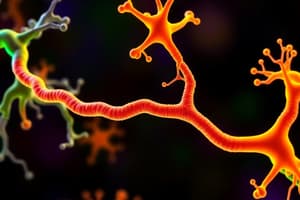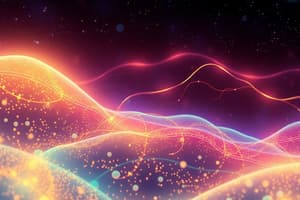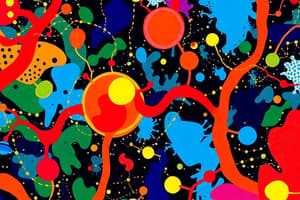Podcast
Questions and Answers
Which of the following is NOT a method by which gated ion channels can be regulated?
Which of the following is NOT a method by which gated ion channels can be regulated?
- Voltage (membrane potential)
- Ligand binding
- Temperature (correct)
- Physical stimuli (mechanosensitive)
Voltage-gated ion channels maintain a constant conformation regardless of the voltage across the membrane.
Voltage-gated ion channels maintain a constant conformation regardless of the voltage across the membrane.
False (B)
What equation is used to determine membrane potential when the membrane is permeable to a single ion?
What equation is used to determine membrane potential when the membrane is permeable to a single ion?
Nernst equation
The equilibrium potential for a single monovalent cation at room temperature can be simplified to $V_{eq} = 58 \text{ mV } \log \frac{[\text{ion}]{out}}{[\text{ion}]{in}}$. In this equation, $V_{eq}$ represents the ______ potential.
The equilibrium potential for a single monovalent cation at room temperature can be simplified to $V_{eq} = 58 \text{ mV } \log \frac{[\text{ion}]{out}}{[\text{ion}]{in}}$. In this equation, $V_{eq}$ represents the ______ potential.
Match the ion channel state with its description.
Match the ion channel state with its description.
What triggers the opening of nicotinic acetylcholine receptors at the neuromuscular junction?
What triggers the opening of nicotinic acetylcholine receptors at the neuromuscular junction?
The action potential propagates down the axon because previously open channels remain open, allowing the signal to move bidirectionally.
The action potential propagates down the axon because previously open channels remain open, allowing the signal to move bidirectionally.
What is the primary function of acetylcholinesterase in the synapse?
What is the primary function of acetylcholinesterase in the synapse?
The resting membrane potential is established primarily by ______ channels.
The resting membrane potential is established primarily by ______ channels.
Match the phase of an action potential with the ion movement primarily responsible for it.
Match the phase of an action potential with the ion movement primarily responsible for it.
Which structural component of voltage-gated channels acts as the voltage sensor?
Which structural component of voltage-gated channels acts as the voltage sensor?
Ligand-gated ion channels transport the ligand itself across the membrane.
Ligand-gated ion channels transport the ligand itself across the membrane.
What is the role of the 'ball-and-chain' structure in the inactivation of some ion channels?
What is the role of the 'ball-and-chain' structure in the inactivation of some ion channels?
In living cells, the membrane potential is governed by the concentrations and permeabilities of ions such as K+, Na+, and ______.
In living cells, the membrane potential is governed by the concentrations and permeabilities of ions such as K+, Na+, and ______.
Match each neuron component with its function.
Match each neuron component with its function.
Which of the following is a characteristic of non-depolarizing neuromuscular blocking agents (NMBAs)?
Which of the following is a characteristic of non-depolarizing neuromuscular blocking agents (NMBAs)?
Neuromuscular blocking agents (NMBAs) directly affect a patient's level of consciousness and ability to feel pain.
Neuromuscular blocking agents (NMBAs) directly affect a patient's level of consciousness and ability to feel pain.
What role does calcium influx play in the release of acetylcholine at the synapse?
What role does calcium influx play in the release of acetylcholine at the synapse?
A key feature of action potentials is their all-or-nothing nature; they are triggered once the membrane potential reaches a specific ______.
A key feature of action potentials is their all-or-nothing nature; they are triggered once the membrane potential reaches a specific ______.
Match the class of ligand-gated ion channels with an example.
Match the class of ligand-gated ion channels with an example.
Which of the following best describes the function of voltage-gated ion channels in an action potential?
Which of the following best describes the function of voltage-gated ion channels in an action potential?
Depolarizing neuromuscular blocking agents are quickly degraded, leading to a brief period of muscle relaxation.
Depolarizing neuromuscular blocking agents are quickly degraded, leading to a brief period of muscle relaxation.
What is the role of Na+/K+ ATPase in establishing the membrane potential.
What is the role of Na+/K+ ATPase in establishing the membrane potential.
The influx of sodium ions into the cell causes the membrane to ______, leading to the rising phase of the action potential.
The influx of sodium ions into the cell causes the membrane to ______, leading to the rising phase of the action potential.
Match each term related to membrane potential with its defintion.
Match each term related to membrane potential with its defintion.
Flashcards
What are ligands?
What are ligands?
Molecules that bind to receptors, triggering a cellular response.
What are primary messengers?
What are primary messengers?
Initial signaling molecules that bind to membrane receptors.
What are second messengers?
What are second messengers?
Small molecules generated inside a cell in response to receptor activation. Signals are amplified.
What is signal transduction?
What is signal transduction?
The series of molecular events that translate an extracellular signal into a cellular response.
Signup and view all the flashcards
What is specificity?
What is specificity?
The degree to which a receptor prefers a specific ligand.
Signup and view all the flashcards
What is affinity?
What is affinity?
The strength of binding between a receptor and its ligand.
Signup and view all the flashcards
What is a subunit?
What is a subunit?
An individual polypeptide chain that makes up a protein complex.
Signup and view all the flashcards
What is conformation?
What is conformation?
The three-dimensional arrangement of atoms in a molecule.
Signup and view all the flashcards
What is an agonist?
What is an agonist?
A molecule that activates a receptor.
Signup and view all the flashcards
What is an antagonist?
What is an antagonist?
A molecule that inhibits a receptor.
Signup and view all the flashcards
What is a membrane channel?
What is a membrane channel?
A channel that allows specific ions to pass through a cell membrane.
Signup and view all the flashcards
What is membrane potential?
What is membrane potential?
The difference in electrical potential across a cell membrane.
Signup and view all the flashcards
What is action potential?
What is action potential?
A rapid, temporary shift in membrane potential, crucial for nerve and muscle function.
Signup and view all the flashcards
What are voltage-gated channels?
What are voltage-gated channels?
Ion channels that open or close in response to changes in membrane potential.
Signup and view all the flashcards
What are ligand-gated channels?
What are ligand-gated channels?
Ion channels that open or close in response to ligand binding.
Signup and view all the flashcards
What are Gated Ion Channels?
What are Gated Ion Channels?
Gated ion channels regulated by a biological signal.
Signup and view all the flashcards
What is membrane potential?
What is membrane potential?
A measure of the unequal distribution of charges across a cell membrane.
Signup and view all the flashcards
What governs membrane potential?
What governs membrane potential?
The concentrations and permeabilities of ions.
Signup and view all the flashcards
What do voltage-gated channels consist of?
What do voltage-gated channels consist of?
Transmembrane helices with an intracellular N-terminus.
Signup and view all the flashcards
What is an action potential?
What is an action potential?
Rapid temporary change in membrane potential due to opening of ion channels.
Signup and view all the flashcards
What are the three phases of action potential?
What are the three phases of action potential?
Depolarization, repolarization, hyperpolarization.
Signup and view all the flashcards
What do ligand-gated channels do?
What do ligand-gated channels do?
Change conformation upon ligand binding.
Signup and view all the flashcards
What are the three classes of ligand-gated channels?
What are the three classes of ligand-gated channels?
Cys-loop, Glutamate, ATP-gated P2X channels.
Signup and view all the flashcards
What does binding of acetylcholine open channels to?
What does binding of acetylcholine open channels to?
Acetylcholine to Na and K ions
Signup and view all the flashcards
How do depolarizing agents work?
How do depolarizing agents work?
Mimicking Ach and opening the ion channels.
Signup and view all the flashcardsStudy Notes
Cell Signaling and Signal Transduction
- Membrane receptors, ligands, primary messengers, and secondary messangers all have roles in signal transduction cascades.
- Hormone molecules can trigger changes inside cells by affecting many molecules.
- Amplification and Attenuation control signals in signaling pathways.
Ion Channels
- Voltage-gated and ligand-gated ion channels have specific functions.
- Ion channels play a role in action potential and at the neuromuscular junction.
- Gated ion channels are regulated by a biological signal via a "gate".
- The gate allows the channel to switch between open and closed conformations.
- When open, ions diffuse following the electrochemical gradient.
- Gating factors include physical stimuli (mechanosensitive), ligand binding, voltage (membrane potential) and pH.
Voltage-Gated Channels
- Voltage-gated membrane channels change conformation in response to voltage fluctuations.
- A transmembrane peptide with a high charge density acts as a voltage sensor.
- Movement of the peptide (perpendicular to the membrane plane) responds to voltage fluctuations, which opens or closes the channel.
Membrane Potential
- Unequal charge distribution across a cell membrane results in the membrane potential.
- Na+-K+ ATPase establishes membrane potential.
- In the simplest case (membrane permeable to a single ion), membrane potential can be determined by the Nernst equation
- In living cells, concentrations and permeabilities of several ions (K+, Na+, and Cl-) govern membrane potential.
- Movement of ions causes redistribution of charge, with influx of + ion (or efflux of – ion) causing depolarization.
Voltage-Gated Channel Structure
- Voltage-gated channels have multiple subunits.
- Each subunit contains six transmembrane helices and an intracellular N-terminus.
- Helices 5 and 6 construct the pore.
- Helix 4 serves as the voltage sensor.
Intracellular N-Terminus
- The intracellular N-terminus of the K+ channel forms an inactivation domain.
- According to the ball-and-chain model, the channel is only open for a brief time interval.
Nerves
- Most neurons consist of a dendrite, a cell body, and an axon.
- Nerve impulses are transmitted via changes in membrane potential.
- Action potential is a rapid, temporary shift in membrane potential, triggered by ion channel opening.
Action Potential Phases
- Action potential has three phases:
- Depolarization is when membrane potential becomes less negative and moves toward a positive charge.
- Repolarization is when membrane potential returns to a negative charge.
- Hyperpolarization is when membrane potential becomes more negative than the resting level.
- Action potential results from a strong inward flow of Na+ (depolarization) followed by a strong outward flow of K+ (repolarization).
- Action potentials propagate rapidly along the length of axons via electrical signaling as charge spreads.
Ligand-Gated Ion Channels
- Ligand-gated ion channels change conformation upon ligand binding.
- Ligands can bind extracellularly or intracellularly.
- Ligands do not get transported across the membrane.
Classes of Ligand-Gated Channels
- There are three classes of ligand-gated channels:
- Cys-loop
- Glutamate (P pore-loop)
- ATP-gated P2X channels
Cys-Loop Channels
- Cys-loop channels have 5 subunits arranged around a pore.
- Each subunit has three domains:
- Extracellular (ligand binding)
- Transmembrane
- Intracellular
- The acetylcholine nicotinic receptor is a Cys-loop channel.
Neuromuscular Junction
- Nicotinic receptors transmit neuronal signals from nerve cells to muscle cells.
- Acetylcholine releases from vesicles in the pre-synaptic neuron.
- Binding of acetylcholine opens channels to Na and K ions
- Acetylcholine (ACh) is a neurotransmitter formed from choline and acetylCoA.
- Acetylcholine is synthesized, stored, and released from cholinergic neurons.
- Acetylcholine releases into the synapse after an influx of Ca2+.
- Muscles contract after receiving signals from motor neurons.
- Acetylcholine degrades in the synapse cleft by acetylcholinesterase.
- Choline transports back into the pre-synaptic cell to be used for ACh synthesis.
Neuromuscular Blockers
- Neuromuscular blocking agents (NMBAs) are nicotinic receptor antagonists used with anesthesia.
- NMBAs induce paralysis.
- NMBAs are used for mechanical ventilation, tracheal intubation, and to relax muscles during surgery.
- NMBAs have no effect on the level of consciousness or ability to perceive pain.
- Nondepolarizing agents are competitive antagonists that bind to the acetylcholine receptor without opening the channel.
- Prevent depolarization of the muscle cell and inhibit muscle contraction.
- Effects can be reversed with acetylcholinesterase inhibitors.
- An example of a nondepolarizing agent is Vecuronium.
- Depolarizing agents mimic Ach, depolarizing the muscle and opening ion channels.
- Depolarizing agents are resistant to degradation so opening of the channel persists.
- Depolarized cells cannot respond to another stimulus, which halts the spread of nerve signal.
- Depolarizing agents first cause muscle contraction (Phase I), then paralysis (Phase II).
- Succinylcholine is a depolarizing agent often used for rapid sequence intubation (RSI).
- Succinylcholine has a rapid onset and a short duration.
Studying That Suits You
Use AI to generate personalized quizzes and flashcards to suit your learning preferences.




